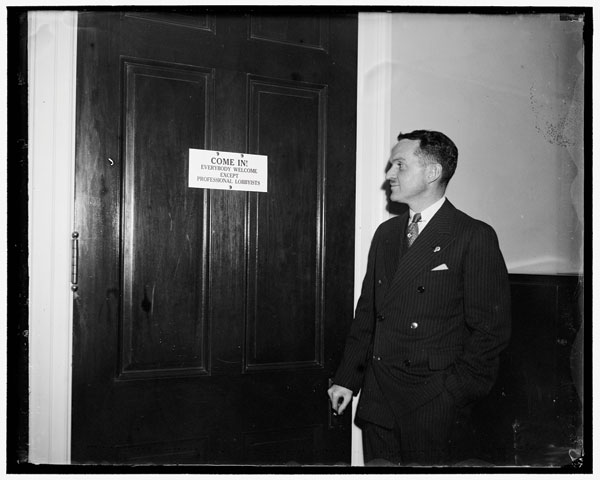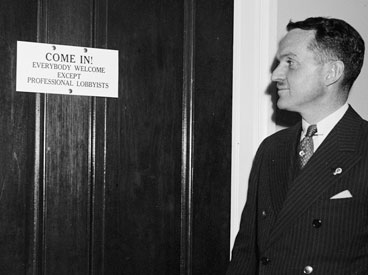
In the latter part of the 19th century, lobbying became more sophisticated and subtle and also more necessary. Necessary because the job of a congressman or senator was getting too complicated. As Byrd put it in his history of lobbying, “Members of Congress, of course, attempt to represent all of the various interests within their constituencies, but they must establish some priorities. Lobbyists attempt to shape those priorities by reminding them of the needs of specific groups. … Lobbyists analyzed bills, prepared arguments in defense of their clients, drafted speeches, contacted committee members, and orchestrated grassroots campaigns in favor of those bills. Now, we accept these lobbying tools as legitimate. Back then, they were suspect, in part, because they were new, and in part, because interests and lobbyists were indiscreet with their use of money to sway votes.” Or as one lobbyist put it at the time, “How can a senator know about a great question unless he keeps himself informed by those who have devoted their lifetime to it and have a lifelong interest in it?”
President Woodrow Wilson was the first national leader to seriously confront the unharnessed power of lobbyists. “Washington,” he said, “has seldom seen so numerous, so industrious, or so insidious a body,” and he began the first reforms of the institution. In 1928 the Senate passed a bill requiring all lobbyists to register, but it died in the House, and one senator, Hiram Bingham of Connecticut, was censured for putting a lobbyist on his payroll.
In the 1930s Sen. Hugo Black of Alabama led an investigation into lobbying that found one congressman had received 816 telegrams about a bill—all written and paid for by a single utility company lobbyist. Black spoke out against the “highpowered, deceptive, telegram-fixing, letterframing, Washington-visiting lobby” and added, “Just contemplate what a good time people are having on your money in Washington!” That began a new focus on the problem that led to a 1946 law that clearly defined lobbyists and required them not only to register in both the House and the Senate but also to submit quarterly reports on money they received and spent and who it came from or went to. Finally that “huge, scaly serpent of the lobby” was being forced out of the shadows.
More had to be done, but not much was for a long time. A 1991 report by the Government Accountability Office found that of 13,500 “key influence peddlers” on Capitol Hill, only 3,500 were registered as lobbyists. That failure was finally addressed in 1995, when President Bill Clinton signed the Lobbying Disclosure Act. It extended registration to anyone who spent more than 20 percent of their time lobbying, and a 2007 bill increased the disclosure requirements further.
Still, the business of lobbying has grown to unprecedented size in the past decades. In 1975 lobbyists spent $100 million a year. Today it’s well north of $2 billion. They’ve continued to have their scandals too, now and then, such as the case of Jack Abramoff, who pled guilty to charges including bribery and tax evasion in 2006 in connection with his lobbying for Native American tribes. He would later admit: “I was participating in a system of legalized bribery. All of it is bribery, every bit of it.”
Yet those scandals are rare now, and there is more sunshine in the system than ever before. Lawrence Lessig, a Harvard Law School professor, wrote a book in 2011 titled Republic, Lost: How Money Corrupts Congress–and a Plan to Stop It, yet he was compelled to admit that “the lobbyist today is ethical, and well educated. He or she works extremely hard to live within the letter of the law. More than ever before, most lobbyists are just well-paid policy wonks, expert in a field and able to advise and guide Congress well. … The ordinary lobbyist today is a Boy Scout compared with the criminal of the 19th century. … But,” he added, “as this practice has become more professional, its effect on our democracy has become more systemic.”
It has become systemic because a powerful relationship has grown up between politicians and lobbyists where each needs the other to survive. Legislators need more cash to run for re-election, and the richest sources of donations are the businesses and organizations that lobbyists represent. How can they resist giving those lobbyists respectful hearings, or much more? Especially when there never need be any direct exchange of funds or buying of votes. The lobbyist is a middleman between a special interest and a legislator, and there’s never a direct connection that can be made between the special interest’s campaign contribution and the legislator’s vote. Lobbyists and legislators are so completely entwined that a revolving door exists between the two careers. In June 2010, more than 172 former members of Congress were registered lobbyists.
And so lobbyists have great power, and sometimes that power has destructive consequences. However, they’ve recently lost one big weapon, at least for the most part, and at least for now. Traditionally the most direct way a member of Congress could do a lobbyist’s bidding has been with the earmark, that very specific local expenditure written into a bigger bill. An earmark can authorize funds specifically for a single contributor’s project, a hospital or factory for instance. However, since 2010, there has been an informal ban on the practice. In 2005 Rep. Randy Cunningham pleaded guilty to charges of taking bribes in return for getting earmarks for defense contractors. The next year he went to prison, and, partly as a result of the scandal, the Republicans lost their majority in the House of Representatives. Four years later, the Republicans took back the House and chose as their majority leader John Boehner of Ohio, who has long opposed earmarks. He has called them “a symbol of a Congress that has broken faith with the people.” On the Democratic side, Barack Obama spoke out strongly against earmarks when he first ran for president in 2008. Legislation to officially ban them has repeatedly failed, but both the House and the Senate have had an informal ban in place for three years now, and it looks likely to last at least a few more. So lobbyists are no longer getting that kind of direct funding for their pet projects, even if they are powerfully affecting bigger, broader legislation—and sometimes inserting giant loopholes like the Amgen one in the fiscal cliff bill.
No question, lobbyists are here to stay. They serve interests large and small, and we all want our interests to be served. There are lobbyists with very narrow bases, like compounding pharmacies, and others with whole populations they represent, like AARP, which addresses issues that affect everyone over 50. There are lobbies that can seem to have outsized power for their constituencies—some would count the National Rifle Association as one, others might say the American Civil Liberties Union. Every one of us is part of many constituencies—you yourself might be, say, a mortgage holder, a senior citizen, a churchgoer, a union member, a gun owner, and an environmentalist all at once—and probably every one of us loves some lobbies and despises others. It’s probably safe to say that almost anyone would love at least one of the following and despise at least one other: the NRA, the ACLU, Greenpeace, the trial lawyers’ lobby, and the oil industry’s lobby.
Very simply, most of us tend to support the lobbyists who promote the causes we believe in most strongly, and we disrespect the lobbyists whose causes we oppose. That just goes to show lobbyists are ultimately but a reflection of the diversity of the nation and of all the people and social groups and businesses that make it up. Today they may be more powerful than ever before, subtly and indirectly trying to buy influence on every issue out there and from every side, but they are also more out in the open and accountable than ever before. Like so much about our system, they are an imperfect necessity. Since every one of them represents interests that at least some of us hold, if we think they’re the enemy then we must agree with Pogo, in the old comic strip, when he said, “We have met the enemy, and he is us.”
The Business of K Street: Since the close of the Civil War, revelations of indiscretion and corruption among the influence peddlers roaming the halls of Congress have shaded the public’s opinion of the profession, casting both suspicion and demands for reform, as illustrated in these 20th century articles from the archive.
Become a Saturday Evening Post member and enjoy unlimited access. Subscribe now



